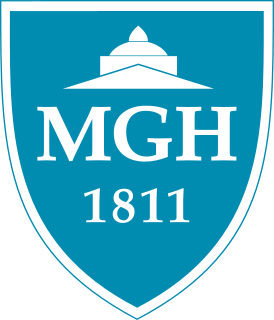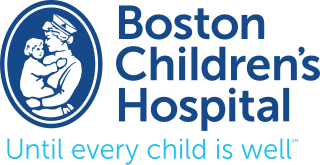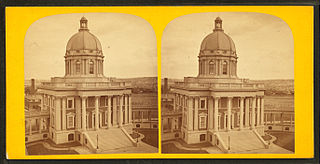Related Research Articles

An emergency department (ED), also known as an accident & emergency department (A&E), emergency room (ER), emergency ward (EW) or casualty department, is a medical treatment facility specializing in emergency medicine, the acute care of patients who present without prior appointment; either by their own means or by that of an ambulance. The emergency department is usually found in a hospital or other primary care center.

Massachusetts General Hospital is the original and largest teaching hospital of Harvard Medical School located in the West End neighborhood of Boston, Massachusetts. It is the third oldest general hospital in the United States and has a capacity of 999 beds. With Brigham and Women's Hospital, it is one of the two founding members of Mass General Brigham, the largest healthcare provider in Massachusetts. Massachusetts General Hospital conducts the largest hospital-based research program in the world, with an annual research budget of more than $1 billion in 2019. It is currently ranked as the #6 best hospital in the United States by U.S. News & World Report.

Boston Children's Hospital formerly known as Children's HospitalBoston until 2012 is a nationally ranked, freestanding acute care children's hospital located in Boston, Massachusetts, adjacent both to its teaching affiliate, Harvard Medical School, and to Dana-Farber Cancer Institute. Dana-Farber and Children's jointly operate the Dana-Farber/Boston Children's Cancer and Blood Disorders Center to deliver comprehensive care for all types of childhood cancers. The hospital is home to the largest hospital based pediatric research program in the world. The hospital features 404 pediatric beds and provides comprehensive pediatric specialties and subspecialties to infants, children, teens, and young adults aged 0–21 throughout Massachusetts, the United States, and the world. The hospital also sometimes treats adults that require pediatric care. The hospital uses the Brigham and Women's Hospital's rooftop helipad and is an ACS verified level I pediatric trauma center, 1 of 3 in Boston. The hospital features a regional pediatric intensive-care unit and an American Academy of Pediatrics verified level IV neonatal intensive care unit. Children's Hospital Boston has been ranked as best pediatric medical center by U.S. News & World Report more times than any other hospital.

The Royal Melbourne Hospital (RMH), located in Parkville, Victoria, an inner suburb of Melbourne, is one of Australia's leading public hospitals. It is a major teaching hospital for tertiary health care with a reputation in clinical research. The hospital is managed as part of Melbourne Health which comprises the Royal Melbourne Hospital, North West Dialysis Service and North Western Mental Health. The Melbourne Health Chief Executive is Christine Kilpatrick AO.

The Boston City Hospital (1864–1996), in Boston, Massachusetts, was a public hospital, located in the South End. It was "intended for the use and comfort of poor patients, to whom medical care will be provided at the expense of the city, and ... to provide accommodations and medical treatment to others, who do not wish to be regarded as dependent on public charity." In 1996, it merged with the Boston University Medical Center Hospital to form the Boston Medical Center.

Vancouver General Hospital is a medical facility located in Vancouver, British Columbia. It is the largest facility in the Vancouver Hospital and Health Sciences Centre (VHHSC) group of medical facilities. VGH is Canada's third largest hospital, after Hamilton General Hospital (1st), and Foothills Medical Centre (2nd).
Katherine Shaw Bethea Hospital is a hospital in Dixon, Illinois. KSB Hospital is an 80-bed acute care facility providing comprehensive ancillary services, including emergency medicine, obstetrics, inpatient psychiatry, a cardiovascular laboratory, outpatient surgery, inpatient surgery, and intensive care, among others.

Letterkenny University Hospital is a general hospital at Letterkenny, County Donegal, in Ulster, Republic of Ireland. One of Ireland's busiest, the campus is divided by a main road heading on towards the North/West of Donegal on the N56 road (Ireland). A teaching hospital, it maintains links with NUI Galway, LYIT and the Royal College of Surgeons.

Boston MedFlight (BMF) is a non-profit organization that provides emergency scene response and emergency interfacility transfer in Eastern Massachusetts at the Critical Care level, which is higher than a paramedic-level ambulance crew's certification, using both aircraft and ground ambulances.
Mayo Hospital is one of the oldest and biggest hospitals in Lahore, Punjab, Pakistan. King Edward Medical University, one of the oldest and most prestigious medical institutions in South Asia, is attached to Mayo Hospital. Mayo Hospital is located in the heart of Old Lahore, and provides free treatment to almost all admitted patients as part of a government policy. It also has many different ward's mainly centered around the Syed A route location.

University of Missouri Health Care is an American academic health system located in Columbia, Missouri. It is owned by the University of Missouri System. University of Missouri Health System includes five hospitals: University Hospital, Ellis Fischel Cancer Center, Missouri Orthopaedic Institute and University of Missouri Women's and Children's Hospital — all of which are located in Columbia. It's affiliated with Capital Region Medical Center in Jefferson City, Missouri as well. It also includes more than 60 primary and specialty-care clinics and the University Physicians medical group.
Spartanburg Regional Healthcare System(SRHS) is one of South Carolina's largest healthcare systems. SRHS draws patients primarily from the areas of Spartanburg, Cherokee, Union and Greenville counties, located in the Piedmont region of South Carolina, and Rutherford and Polk counties, located in western North Carolina. Spartanburg General Hospital was organized under the authority of the South Carolina General Assembly in 1917, and officially became the Spartanburg Regional Health Services District, Inc., a political subdivision of the State of South Carolina, by charter granted by the secretary of state of South Carolina on May 1, 1995.

Tufts Medical Center in Boston, Massachusetts is a downtown Boston hospital occupying space between Chinatown and the Boston Theater District.

Baptist Health, headquartered in Jacksonville, Florida, is a faith-based, non-profit health system comprising six hospitals with 1,168 beds, a cancer center, four satellite emergency departments and more than 200 patient access points of care, including 50 primary care offices located throughout northeast Florida and southeast Georgia. Wolfson Children's Hospital, Baptist Medical Center Jacksonville, Baptist Heart Hospital, Baptist Medical Center Nassau, Baptist Medical Center Beaches, and Baptist Medical Center South are Magnet Hospitals.

MelroseWakefield Hospital is a 234-bed non-profit hospital located in Melrose, Massachusetts. MelroseWakefield Hospital is affiliated with Lawrence Memorial Hospital of Medford. MelroseWakefield Hospital provides many different areas of patient care including inpatient Medical Surgical, Telemetry, Maternity, Labor and Delivery, and Psychiatric, in addition to many outpatient services.

Newton-Wellesley Hospital (NWH) is a community teaching medical center located in Newton, Massachusetts on Washington Street. It is affiliated with Tufts University School of Medicine and Harvard Medical School. Founded in 1881, part of its campus is listed on the National Register of Historic Places as the Newton Cottage Hospital Historic District.

Adventist Health Portland, is a 302-bed hospital serving 900,000 residents on the east side of the Portland-Vancouver metropolitan area in the United States. It is the primary teaching hospital of the Walla Walla University Nursing program.

Adventist Health Feather River, also known as Feather River Hospital, is a 101-bed acute care hospital located in the town of Paradise, in Butte County, California, with a wide array of outpatient departments and services designed to meet the health care needs of Paradise, Magalia, and neighboring communities. It was severely damaged in the November 2018 Camp Fire and is currently closed.
Saugus General Hospital was a hospital located in Saugus, Massachusetts. At the time of its closure, Saugus General Hospital was a 109-bed facility with surgical facilities, x-ray rooms, a laboratory, a pharmacy, and a cafeteria located in two interconnected buildings.
George William Galvin (1854–1928) was an American physician who was the founder of the Boston Emergency and General Hospital, the first emergency hospital in the United States.
References
- ↑ "All Don't Agree". The Boston Daily Globe. June 22, 1901.
- ↑ Trickey, Henry G. (July 3, 1891). "Speedy Aid To Injured". The Boston Daily Globe.
- 1 2 "Established 14 Years". The Boston Daily Globe. March 11, 1906.
- ↑ "Have Changed Their Minds". The Boston Daily Globe. March 28, 1896.
- 1 2 "Letters to the Editor". The Boston Daily Globe. December 3, 1904. Retrieved June 28, 2019.
- ↑ "Dr. George Galvin Has Passed Away". The Boston Daily Globe. August 17, 1928.
- ↑ "Dr. Galvin's Decision". The Boston Daily Globe. February 7, 1903.
- 1 2 3 "Enlarged and Improved: Boston Emergency Hospital on Kingston St Has Remodeled Building and Three New Departments". The Boston Daily Globe. September 19, 1904.
- ↑ "Emergency Hospital Reopens". The Boston Daily Globe. September 20, 1899.
- 1 2 3 "With New Features: Emergency and General Hospital Opened". The Boston Daily Globe. November 10, 1904.
- ↑ "Leaves Emergency". The Boston Daily Globe. March 11, 1906.
- ↑ "Takes Grace Hospital". The Boston Daily Globe. July 1, 1911.
- ↑ "Tufts College Now In Charge". The Boston Daily Globe. March 11, 1906.
- ↑ "Grace Hospital Decision". The Boston Daily Globe. September 14, 1912.
- ↑ "Boston". The Reference Register. New York: Phillips' Directories Company. 1918. Retrieved June 29, 2019.